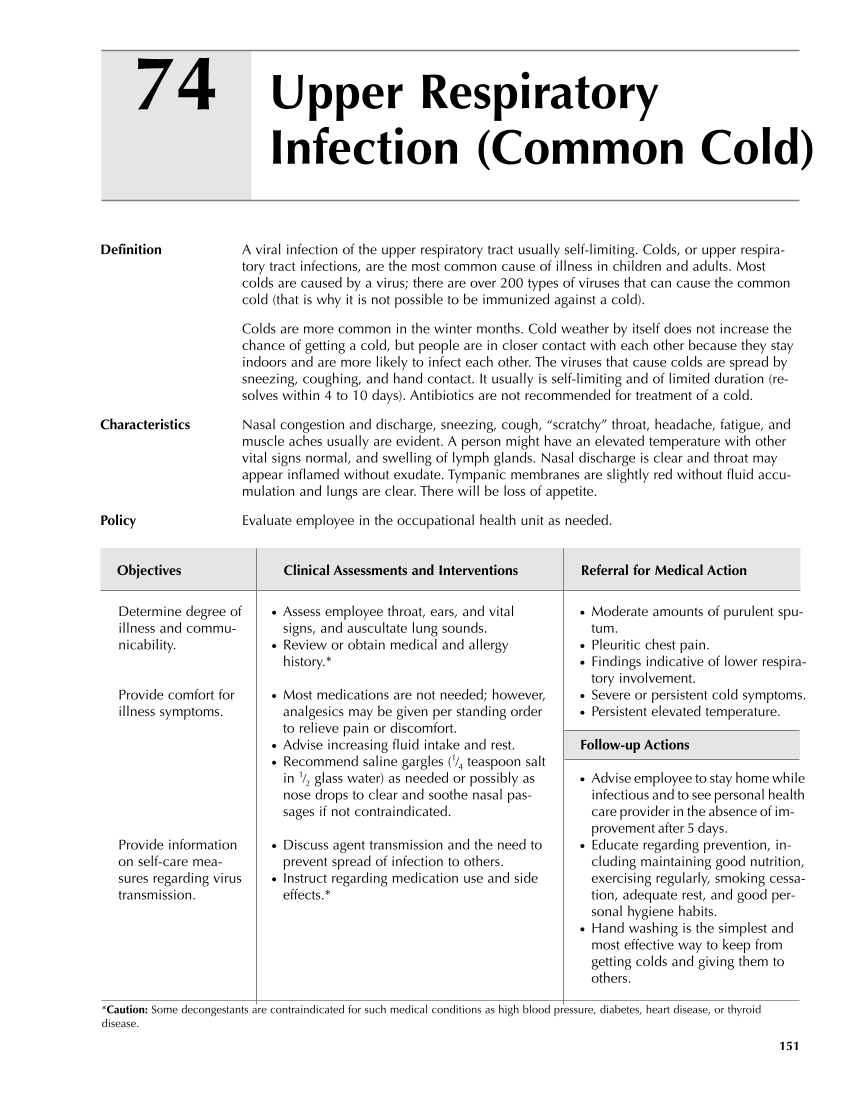151 Upper Respiratory Infection (Common Cold) 74 Definition A viral infection of the upper respiratory tract usually self-limiting. Colds, or upper respira- tory tract infections, are the most common cause of illness in children and adults. Most colds are caused by a virus there are over 200 types of viruses that can cause the common cold (that is why it is not possible to be immunized against a cold). Colds are more common in the winter months. Cold weather by itself does not increase the chance of getting a cold, but people are in closer contact with each other because they stay indoors and are more likely to infect each other. The viruses that cause colds are spread by sneezing, coughing, and hand contact. It usually is self-limiting and of limited duration (re- solves within 4 to 10 days). Antibiotics are not recommended for treatment of a cold. Characteristics Nasal congestion and discharge, sneezing, cough, “scratchy” throat, headache, fatigue, and muscle aches usually are evident. A person might have an elevated temperature with other vital signs normal, and swelling of lymph glands. Nasal discharge is clear and throat may appear inflamed without exudate. Tympanic membranes are slightly red without fluid accu- mulation and lungs are clear. There will be loss of appetite. Policy Evaluate employee in the occupational health unit as needed. Objectives Clinical Assessments and Interventions Referral for Medical Action ● Moderate amounts of purulent spu- tum. ● Pleuritic chest pain. ● Findings indicative of lower respira- tory involvement. ● Severe or persistent cold symptoms. ● Persistent elevated temperature. Follow-up Actions ● Advise employee to stay home while infectious and to see personal health care provider in the absence of im- provement after 5 days. ● Educate regarding prevention, in- cluding maintaining good nutrition, exercising regularly, smoking cessa- tion, adequate rest, and good per- sonal hygiene habits. ● Hand washing is the simplest and most effective way to keep from getting colds and giving them to others. Determine degree of illness and commu- nicability. Provide comfort for illness symptoms. Provide information on self-care mea- sures regarding virus transmission. ● Assess employee throat, ears, and vital signs, and auscultate lung sounds. ● Review or obtain medical and allergy history.* ● Most medications are not needed however, analgesics may be given per standing order to relieve pain or discomfort. ● Advise increasing fluid intake and rest. ● Recommend saline gargles (1/4 teaspoon salt in 1/2 glass water) as needed or possibly as nose drops to clear and soothe nasal pas- sages if not contraindicated. ● Discuss agent transmission and the need to prevent spread of infection to others. ● Instruct regarding medication use and side effects.* *Caution: Some decongestants are contraindicated for such medical conditions as high blood pressure, diabetes, heart disease, or thyroid disease.
Purchased from OEM Press by (ge corporate access). (C) 2013 OEM Health Information, Inc. All rights reserved.












































































































































































































































































































































































































































